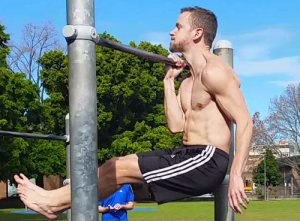Calisthenics is body-weight strength training, so you mainly use your body weight for resistance instead of weights. Strength training offers a range of benefits: building muscle mass and strength leads to a more toned appearance, stronger bones, improved joint protection, and a reduced risk of injuries.
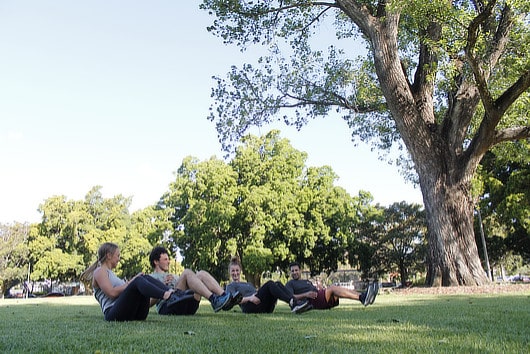
Common myths/ concerns:
- I’m Not Strong Enough for Calisthenics
- I Need Weights to Build Muscle
- Is Calisthenics a Suitable Training Regime for Post 40?
- I Don’t Have a Gym Membership or Equipment
- I’m Interested but Don’t Know Where to Begin
- I’ve Tried Teaching Myself Calisthenics, and I Can’t Get Into It
- I Don’t Think I Have Enough Time to Do Calisthenics
- I Have Concerns About Injuries
- I Haven’t Seen Many People With a Similar Body Type Doing Calisthenics
- Staying Motivated and Disciplined Can Be Tough for Me
1. I’m Not Strong Enough for Calisthenics
When people enquire about calisthenics training, we often hear this statement:
“I’m really weak, can I still do calisthenics? I can’t even do a push-up”.
The answer is yes you can. Why?
Because calisthenics is based on progressions.
This means there are exercises that suit most people and abilities, even complete beginners or people who identify as being “weak”.
An example exercise for a beginner student is a wall or inclined push-up.
We start by getting the technique right without loading up the arms with lots of weight.
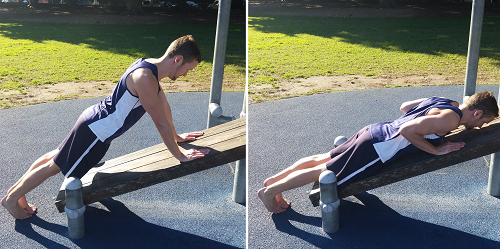
Over time, our students see progress and we can move them on to different exercises or progressions.
The more sessions you attend consistently, the faster your progress. However, we are firm believers in resting between workouts to allow for recovery. We can talk about this at your free launch session.
2. I Need Weights to Build Muscle
This is a common objection regarding calisthenics, but it’s a misconception. You don’t necessarily need weights to build muscle.
Muscle growth is triggered by resistance and tension, not necessarily by weights.

Calisthenics exercises like push-ups, pull-ups, squats, and dips provide ample resistance by leveraging your body weight against gravity.
- Just like weight training, calisthenics follows the principle of progressive overload
- You can gradually increase the resistance by changing the leverage, increasing the number of repetitions, or trying more challenging variations of the exercises
- This progressive overload is essential for continuous muscle growth
Of course, you can incorporate weights into calisthenics routines, such as performing weighted pull-ups, to continually increase the challenge and advance your progress.
3. Is Calisthenics a Suitable Training Regime for Post 40?
Calisthenics is an excellent training choice for people at any stage of life, including those over 40.
Our group training or personal training (PT) sessions are designed to build strength, foster social connections, and offer the benefits of outdoor exercise. With expert trainers ready to develop a custom programme, you’ll receive guidance tailored to your needs and goals.
Calisthenics exercises involve multi-directional mechanical loads and strains on the bones through compound bodyweight movements, such as:
- Push-ups load the wrists, arms, chest and shoulders
- Squats load the hips, legs and spine
- Pull-ups load the arms and back
- Core exercises like planks load the entire trunk
By progressively overloading these movements, your bones sense the increasing strain and may respond by building more bone mass and improving structure in the loaded areas.[1]
Incorporating challenging calisthenics exercises that load the bones from multiple directions provides a highly effective, weight-bearing stimulus to promote bone health and may help prevent osteoporosis and fractures later in life.
“Impact and resistance exercise should be advocated for the prevention of osteoporosis.”[2]

4. I Don’t Have a Gym Membership or Equipment
One of the biggest advantages of calisthenics is that it requires minimal to no equipment, making it highly accessible for anyone, anywhere. Unlike traditional weight training that requires access to a gym or home equipment, calisthenics uses your own bodyweight as resistance.

You can perform calisthenics exercises almost anywhere, whether at home, in a park, or even during your travels.
Of course, you can still do calisthenics at the gym or do calisthenics alongside your gym routine too if you want to do both.
5. I’m Interested but Don’t Know Where to Begin
It’s natural to feel hesitant or unsure about starting a new fitness routine, anything that’s unfamiliar can trigger these feelings.
Rest assured that when you train with us you will be looked after right from the beginning. From your free launch session, where we can discuss your goals, concerns and any injuries you may have.
We’ll develop a training plan that suits your needs and your level so you can train with confidence.
You’ll find that quite quickly you will start making progress, you may notice changes in your body (hello more toned physique) and of course you will feel part of the community almost instantly (we’re a friendly bunch!).
Please reach out if you have any questions about training with us, or book your free launch session.
6. I’ve Tried Teaching Myself Calisthenics, and I Can’t Get Into It
If you’ve tried doing calisthenics yourself, there could be a few reasons that were holding you back. Do any of these ring a bell?
Finding the exercises repetitive, feeling lonely and less motivated training alone, not knowing how to progress exercises, not tracking progress, or lack of consistency.
There are 5 primary aspects to tackle here:
- Consistency – training at least 3-4 times a week for best results. If you are a beginner you may want to slowly build up to this, starting with twice a week.
- Working out with others – If you can’t achieve this working out alone, then consider finding a workout partner, joining a calisthenics group or joining our classes if you’re based in Sydney.
Training in a group can help keep you accountable and the social aspect makes you feel great so you’ll want to come back for more. Many of our students join us for the added benefit of training outdoors – there’s something about being out in the fresh air that just makes you feel good. - Mix up the routine – It might be time to mix up the routine and get some different exercises or progressions to help with motivation and make you feel like you are trying something new.
Particularly if you are someone who has had to stop and return to training multiple times, it can be disheartening to go back to square one each time.
Advanced athletes can work towards a new skill to mix up training and refresh motivation. - Track your workouts – It might seem like one more thing to do!
However, if you track your results and see how they change week over week, you may find that this also helps keep you motivated.
If you wing your workouts each week, you may be less inclined to move to the next progression or increase reps when it’s time. Tracking your workouts helps keep your workouts fresh and updated. - Learn how to move correctly – Following generic programs, you’ve found on the internet, may lead to ingraining bad habits which will need to be unlearned before progress can begin again. This is where our experienced coaches shine. They will have you perform exercises correctly, preventing injuries and helping you push through plateaus.
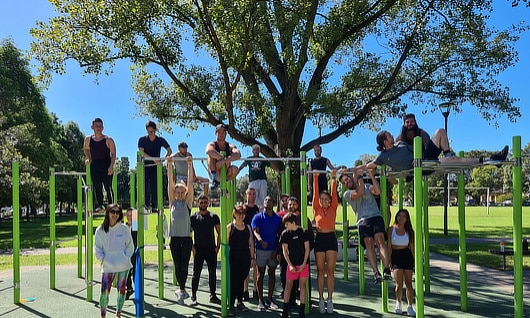
By incorporating these tips, you can transform your calisthenics training from monotonous routines into a dynamic and fun journey towards achieving your fitness goals.
When you see progress it will give you extra motivation to stick to your routine, we’ve seen it time and time again.
7.I Don’t Think I Have Enough Time to Do Calisthenics
Busy schedules filled with work, family commitments, and other responsibilities can leave limited time for dedicated workouts. Huh! When do I fit it all in?!
Before we address that, first know that your health and fitness is also an important aspect of your life that can’t be overlooked.
Prioritising Your Self Care
When you are fit and strong, everything else in life is a little bit easier, you can run around longer with the kids, show up more confidently at work and have more energy to do the things you enjoy.
So know you deserve time to workout and be the best version of yourself, if you don’t look after yourself no one else will. Find the time!
If You Are Struggling To Find Time
Here are some things to consider for the time poor calisthenics enthusiast:
- Shorter workouts – Opt for more frequent shorter workouts. Even 20 mins is a good place to start.
- Consider before work, lunchtimes, evening or weekend sessions to get your workouts in.
Our calisthenics classes are typically 45 minutes long – though they can be adapted if you need to leave the session sooner. - If you work from home, consider doing short workouts 10-15 minute sessions throughout the day.
- Focus on compound exercises so you get multiple muscle groups working all at once (pushups, rows, squats, push-ups, dips etc…).
- Don’t forget to warm up and find time each week to stretch/ work on mobility.
- Schedule your weeks in advance: block out time for appointments, family time and events and your workouts.
When you plan and let people know you are unavailable at those times it will be easier to stick to a consistent schedule.
- Know you are worth it – ‘future you’ will thank the ‘present you’ for taking action for a healthier future body!
8. I Have Concerns About Injuries
Starting a new exercise regime can feel intimidating, especially if you are struggling with previous injuries.
If you are considering training with Maximum Potential Calisthenics, please know that we don’t get you straight into a full workout.
Our students ease into their new training plan to ensure correct form and progress. Exercises can be progressed at each workout or week on week depending on the individual.
Learn more about starting training with us below.

Starting A New Training Regime Correctly
Step 1
First, you can attend a free launch session. This is a 1:1 complimentary session where we discuss your goals and injuries or past injuries that we may need to consider when creating your training plan. We’ll do a few basic exercises to make sure that we establish the correct starting level.
This session is also an opportunity to introduce you to a few calisthenics exercises and teach
you the correct way to perform exercises.
Step 2
Choose your preferred classes for the week and book in on our booking app.
Step 3
Attend class – we will usually start you on 3/5ths of a typical workout to ease you into training, particularly if you are a complete beginner to strength training.
During classes, you will get plenty of help and opportunities to ask your coach about the exercises and your coach will be closely monitoring your form.
We’ll help you set up your program on a free app, so you can track your progress and complete workouts at home, gym or park when you can’t attend classes.
9. I Haven’t Seen Many People With a Similar Body Type Doing Calisthenics, so I’m a Bit Hesitant
This is a common misconception. While many calisthenics athletes you see online may have leaner physiques, calisthenics is suitable for all body types and sizes.
We have students across a wide range of height, weight and build who are progressing remarkably well with consistent training.
Our 90kg+ students are living proof that with dedication, training at least 3-4 times per week, you can build significant strength and skills regardless of your body shape.
The key is consistency and progressive overload.
Don’t let your perceived limitations hold you back from trying calisthenics – the principles apply to everyone, and the rewards of increased strength and mobility are well worth it.
10. Staying Motivated and Disciplined Can Be Tough for Me
Focus on your why.
You may want to think about why you want to exercise, your ‘why’ can help you stay accountable.
Is it to live a longer healthier life to be there for your kids? Is it to feel better in your body? To prevent immobility later in life? To manage stress? Or perhaps it’s for the social aspect.
Focusing on your why each week may help you to show up each week. Have the bigger picture in mind.
Let’s explore motivation a little further…
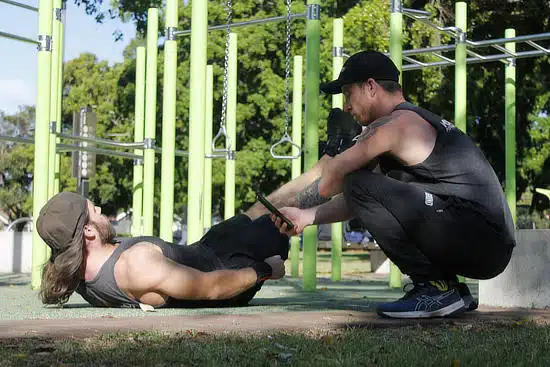
People usually start a new exercise regime, like calisthenics for one of the following reasons:
- Dispositional motives – These are the broad life goals and values that a person holds, like being healthy, looking good, or connecting with others.
- Participatory motives – These are the specific reasons why someone wants to exercise, like improving fitness, managing stress, or gaining social recognition.
- Regulatory motives – These are the drivers that directly influence exercise behaviour, like enjoyment, feeling obligated, or seeking external rewards.
A study found that people who exercise regularly tend to be motivated by enjoyment and personally meaningful reasons like health and fitness. [3]

Choose a Schedule and Stick to It (No Matter What)
Plan out your workout schedule in advance – taking into consideration your other commitments for the week ahead.
Block that time out in your calendar and stick to showing up consistently. No excuses. It will get easier each time you show up and you will miss it if you don’t.
Track Your Progress
Track your progress for each session so you can improve each week.
It will take the guesswork out of your workouts and allow you to show up with confidence.
Join A Group
If you are in Sydney come and join our calisthenics classes, otherwise find a workout partner or group you can join to help keep you on track.
Training with a coach is a great way to make sure you are accountable and performing exercises correctly.
At Maximum Potential Calisthenics, our students have the opportunity to join our group chats, where they can post progress and updates.
Seeing fellow students post their updates can be a great inspiration to get in that extra bridge or handstand for the day!
Enjoy the Process and Reflect on How Far You Have Come
Take the time to perform your exercises mindfully, enjoy the feeling of your body moving, getting stronger at each workout.|
Don’t forget to reflect on your progress and soak in the feel-good factor of getting another workout in!
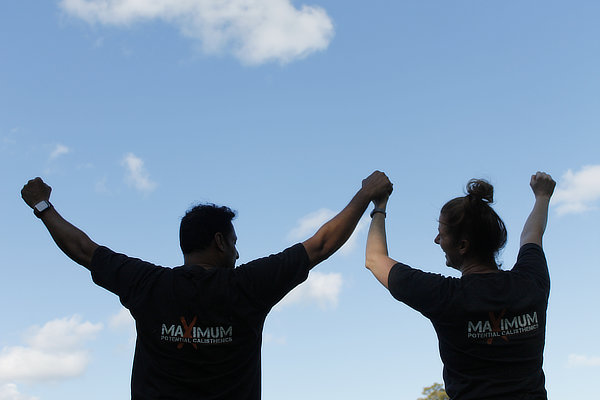
To Wrap Up...
- Calisthenics is a versatile and accessible form of training suitable for individuals of all levels, from beginners to experienced athletes
- Whether your goal is to improve strength, protect your joints, boost energy levels, or develop a toned physique, calisthenics offers a range of exercises and progressions to meet your needs
- The beauty of bodyweight training lies in its scalability, allowing you to continuously set new challenges and work towards achieving goals that once seemed out of reach!
Want To Train With Us In Sydney?
Learn more about our training options here, or book in your free launch session below:




